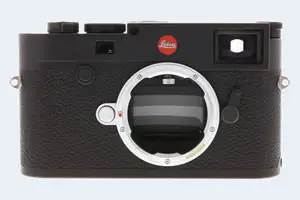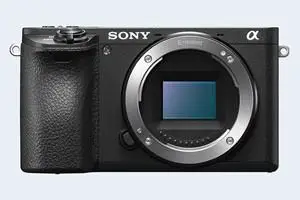Leica M10 vs Sony A6500
The Leica M10 (Typ 3656) and the Sony Alpha A6500 are two enthusiast cameras that were revealed to the public, respectively, in January 2017 and October 2016. The M10 is a rangefinder-focusing mirrorless, while the A6500 is a mirrorless interchangeable lens camera. The cameras are based on a full frame (M10) and an APS-C (A6500) sensor. The Leica has a resolution of 23.8 megapixels, whereas the Sony provides 24 MP.
Below is an overview of the main specs of the two cameras as a starting point for the comparison.

Check M10 offers at
ebay.com

Check A6500 offers at
ebay.com
Going beyond this snapshot of core features and characteristics, what are the differences between the Leica M10 (Typ 3656) and the Sony Alpha A6500? Which one should you buy? Read on to find out how these two cameras compare with respect to their body size, their imaging sensors, their shooting features, their input-output connections, and their reception by expert reviewers.
Body comparison
An illustration of the physical size and weight of the Leica M10 and the Sony A6500 is provided in the side-by-side display below. The two cameras are presented according to their relative size. Three consecutive views from the front, the top, and the rear side are shown. All size dimensions are rounded to the nearest millimeter.
The M10 can be obtained in two different colors (black, silver), while the A6500 is only available in black.
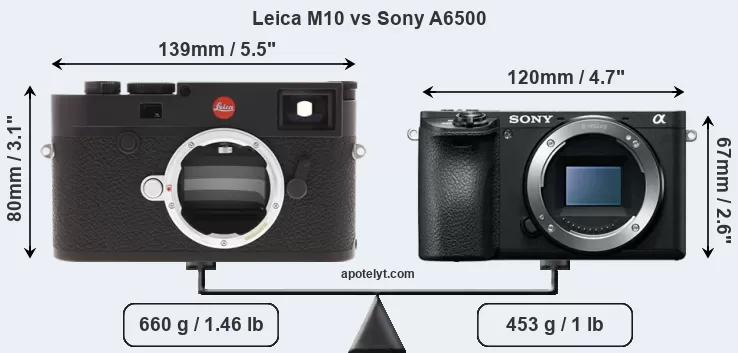

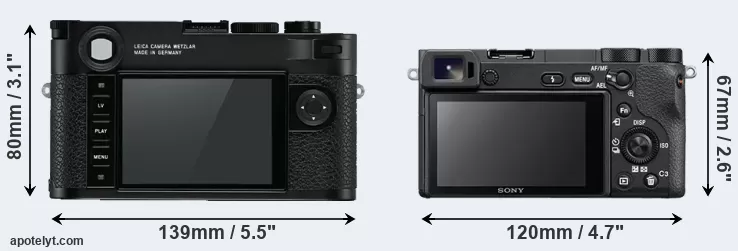
If the front view area (width x height) of the cameras is taken as an aggregate measure of their size, the Sony A6500 is notably smaller (28 percent) than the Leica M10. Moreover, the A6500 is markedly lighter (31 percent) than the M10. In this context, it is worth noting that both cameras are splash and dust-proof and can, hence, be used in inclement weather conditions or harsh environments.
The above size and weight comparisons are to some extent incomplete since they do not consider the interchangeable lenses that both of these cameras require. A larger imaging sensor will tend to go along with bigger and heavier lenses, although exceptions exist. You can compare the optics available for the two cameras in the Leica M Lens Catalog (M10) and the Sony E-Mount Lens Catalog (A6500).
Concerning battery life, the M10 gets 210 shots out of its Leica BP-SCL5 battery, while the A6500 can take 350 images on a single charge of its Sony NP-FW50 power pack. The power pack in the A6500 can be charged via the USB port, which can be very convenient when travelling.
The table below summarizes the key physical specs of the two cameras alongside a broader set of comparators. If you want to switch the focus of the display and review another camera pair, you can move across to the CAM-parator tool and choose from the broad selection of possible camera comparisons there.

| Camera Model |
Camera Width |
Camera Height |
Camera Depth |
Camera Weight |
Battery Life |
Weather Sealing |
Camera Launch |
Launch Price |
Street Price |
||
|---|---|---|---|---|---|---|---|---|---|---|---|
| 1. | Leica M10 | 139 mm | 80 mm | 39 mm | 660 g | 210 | Y | Jan 2017 | US$ 6 599 | ebay.com | |
| 2. | Sony A6500 | 120 mm | 67 mm | 53 mm | 453 g | 350 | Y | Oct 2016 | US$ 1 399 | ebay.com | |
| 3. | Canon 1D X Mark II | 158 mm | 168 mm | 83 mm | 1530 g | 1210 | Y | Feb 2016 | US$ 5 999 | ebay.com | |
| 4. | Canon 6D Mark II | 144 mm | 111 mm | 75 mm | 765 g | 1200 | Y | Jun 2017 | US$ 1 999 | amazon.com | |
| 5. | Leica M Typ 240 | 139 mm | 80 mm | 42 mm | 680 g | 500 | Y | Sep 2012 | US$ 6 949 | ebay.com | |
| 6. | Leica M-E Typ 240 | 139 mm | 80 mm | 42 mm | 680 g | 500 | Y | Jun 2019 | US$ 3 999 | ebay.com | |
| 7. | Leica M Typ 262 | 139 mm | 80 mm | 42 mm | 680 g | 400 | Y | Nov 2015 | US$ 5 195 | ebay.com | |
| 8. | Leica M10-P | 139 mm | 80 mm | 39 mm | 660 g | 210 | Y | Aug 2018 | US$ 7 999 | ebay.com | |
| 9. | Leica M11 | 139 mm | 80 mm | 39 mm | 640 g | 700 | Y | Jan 2022 | US$ 8 999 | amazon.com | |
| 10. | Leica Q Typ 116 | 130 mm | 80 mm | 93 mm | 640 g | 300 | n | Jun 2015 | US$ 4 249 | ebay.com | |
| 11. | Leica SL | 147 mm | 104 mm | 39 mm | 847 g | 400 | Y | Oct 2015 | US$ 7 449 | ebay.com | |
| 12. | Nikon D5 | 160 mm | 159 mm | 92 mm | 1415 g | 3780 | Y | Jan 2016 | US$ 6 499 | ebay.com | |
| 13. | Panasonic GX8 | 133 mm | 78 mm | 63 mm | 487 g | 330 | Y | Jul 2015 | US$ 1 199 | ebay.com | |
| 14. | Sony A77 | 143 mm | 104 mm | 81 mm | 732 g | 470 | Y | Aug 2011 | US$ 1 399 | ebay.com | |
| 15. | Sony A6300 | 120 mm | 67 mm | 49 mm | 404 g | 400 | Y | Feb 2016 | US$ 999 | ebay.com | |
| 16. | Sony A6600 | 120 mm | 67 mm | 69 mm | 503 g | 810 | Y | Aug 2019 | US$ 1 399 | amazon.com | |
| 17. | Sony A6700 | 122 mm | 69 mm | 64 mm | 493 g | 570 | Y | Jul 2023 | US$ 1 399 | amazon.com | |
| Note: Measurements and pricing do not include easily detachable parts, such as add-on or interchangeable lenses or optional viewfinders. | |||||||||||
Any camera decision will obviously take relative prices into account. The manufacturer’s suggested retail prices give an idea on the placement of the camera in the maker’s lineup and the broader market. The A6500 was launched at a markedly lower price (by 79 percent) than the M10, which puts it into a different market segment. Normally, street prices remain initially close to the MSRP, but after a couple of months, the first discounts appear. Later in the product cycle and, in particular, when the replacement model is about to appear, further discounting and stock clearance sales often push the camera price considerably down.
Sensor comparison
The imaging sensor is at the core of digital cameras and its size is one of the main determining factors of image quality. A large sensor will generally have larger individual pixels that offer better low-light sensitivity, provide wider dynamic range, and have richer color-depth than smaller pixels in a sensor of the same technological generation. Furthermore, a large sensor camera will give the photographer more possibilities to use shallow depth-of-field in order to isolate a subject from the background. On the downside, larger sensors are more costly to manufacture and tend to lead to bigger and heavier cameras and lenses.
Of the two cameras under consideration, the Leica M10 features a full frame sensor and the Sony A6500 an APS-C sensor. The sensor area in the A6500 is 57 percent smaller. As a result of these sensor size differences, the cameras have a format factor of, respectively, 1.0 and 1.5. Both cameras have a native aspect ratio (sensor width to sensor height) of 3:2.
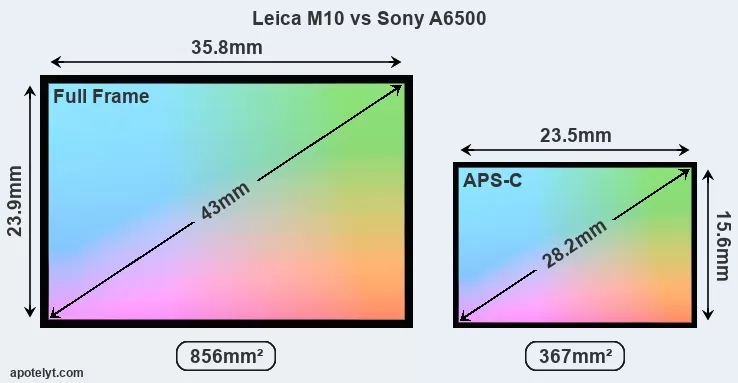
Despite having a smaller sensor, the A6500 offers a slightly higher resolution of 24 megapixels, compared with 23.8 MP of the M10. This megapixels advantage comes at the cost of a higher pixel density and a smaller size of the individual pixel (with a pixel pitch of 3.91μm versus 6.00μm for the M10). Moreover, it should be noted that the M10 is a somewhat more recent model (by 3 months) than the A6500, and its sensor might have benefitted from technological advances during this time that further enhance the light gathering capacity of its pixels. Coming back to sensor resolution, it should be mentioned that the M10 has no anti-alias filter installed, so that it can capture all the detail its sensor resolves.
The A6500 has on-sensor phase detect pixels, which results in fast and reliable autofocus acquisition even during live view operation.
The Leica M10 (Typ 3656) has a native sensitivity range from ISO 100 to ISO 50000. The corresponding ISO settings for the Sony Alpha A6500 are ISO 100 to ISO 25600, with the possibility to increase the ISO range to 100-51200.
Technology-wise, both cameras are equipped with CMOS (Complementary Metal–Oxide–Semiconductor) sensors. Both cameras use a Bayer filter for capturing RGB colors on a square grid of photosensors. This arrangement is found in most digital cameras.
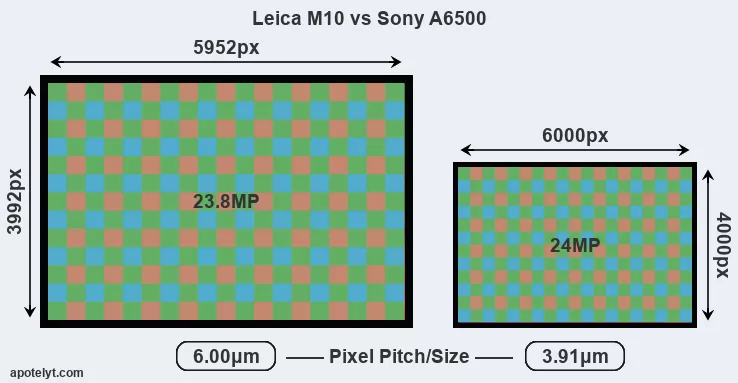
For many cameras, data on sensor performance has been reported by DXO Mark. This service assesses and scores the color depth ("DXO Portrait"), dynamic range ("DXO Landscape"), and low-light sensitivity ("DXO Sports") of camera sensors, and also publishes an overall camera score. The Overall DXO ratings for the two cameras under consideration are close, suggesting that they provide similar imaging performance. The table below summarizes the physical sensor characteristics and sensor quality findings and compares them across a set of similar cameras.

| Camera Model |
Sensor Class |
Resolution (MP) |
Horiz. Pixels |
Vert. Pixels |
Video Format |
DXO Portrait |
DXO Landscape |
DXO Sports |
DXO Overall |
||
|---|---|---|---|---|---|---|---|---|---|---|---|
| 1. | Leica M10 | Full Frame | 23.8 | 5952 | 3992 | none | 24.4 | 13.2 | 2133 | 86 | |
| 2. | Sony A6500 | APS-C | 24.0 | 6000 | 4000 | 4K/30p | 24.5 | 13.7 | 1405 | 85 | |
| 3. | Canon 1D X Mark II | Full Frame | 20.0 | 5472 | 3648 | 4K/60p | 24.1 | 13.5 | 3207 | 88 | |
| 4. | Canon 6D Mark II | Full Frame | 26.0 | 6240 | 4160 | 1080/60p | 24.4 | 11.9 | 2862 | 85 | |
| 5. | Leica M Typ 240 | Full Frame | 23.7 | 5952 | 3976 | 1080/25p | 24.0 | 13.3 | 1860 | 84 | |
| 6. | Leica M-E Typ 240 | Full Frame | 23.7 | 5952 | 3976 | 1080/25p | 25.2 | 14.2 | 2821 | 94 | |
| 7. | Leica M Typ 262 | Full Frame | 23.7 | 5952 | 3976 | none | 24.8 | 13.7 | 2478 | 90 | |
| 8. | Leica M10-P | Full Frame | 23.8 | 5952 | 3992 | none | 25.1 | 14.1 | 2739 | 93 | |
| 9. | Leica M11 | Full Frame | 60.3 | 9528 | 6328 | none | 26.3 | 14.8 | 3376 | 100 | |
| 10. | Leica Q Typ 116 | Full Frame | 24.0 | 6000 | 4000 | 1080/60p | 24.3 | 12.7 | 2221 | 85 | |
| 11. | Leica SL | Full Frame | 24.0 | 6000 | 4000 | 4K/30p | 25.0 | 13.4 | 1821 | 88 | |
| 12. | Nikon D5 | Full Frame | 20.7 | 5588 | 3712 | 4K/30p | 25.1 | 12.3 | 2343 | 88 | |
| 13. | Panasonic GX8 | Four Thirds | 20.2 | 5184 | 3888 | 4K/30p | 23.5 | 12.6 | 806 | 75 | |
| 14. | Sony A77 | APS-C | 24.0 | 6000 | 4000 | 1080/60p | 24.0 | 13.2 | 801 | 78 | |
| 15. | Sony A6300 | APS-C | 24.0 | 6000 | 4000 | 4K/30p | 24.4 | 13.7 | 1437 | 85 | |
| 16. | Sony A6600 | APS-C | 24.0 | 6000 | 4000 | 4K/30p | 23.8 | 13.4 | 1497 | 82 | |
| 17. | Sony A6700 | APS-C | 25.6 | 6192 | 4128 | 4K/120p | 24.3 | 14.0 | 2329 | 86 | |
| Note: DXO values in italics represent estimates based on sensor size and age. | |||||||||||
Many modern cameras cannot only take still pictures, but also record videos. The A6500 indeed provides for movie recording, while the M10 does not. The highest resolution format that the A6500 can use is 4K/30p.
Feature comparison
Beyond body and sensor, cameras can and do differ across a range of features. For example, the A6500 has an electronic viewfinder (2359k dots), while the M10 has an optical one. Both systems have their advantages, with the electronic viewfinder making it possible to project supplementary shooting information into the framing view, whereas the optical viewfinder offers lag-free viewing and a very clear framing image. The viewfinders of both cameras offer the same field of view (100%), but the viewfinder of the M10 has a higher magnification than the one of the A6500 (0.73x vs 0.70x), so that the size of the image transmitted appears closer to the size seen with the naked human eye. The adjacent table lists some of the other core features of the Leica M10 and Sony A6500 along with similar information for a selection of comparators.

| Camera Model |
Viewfinder (Type or 000 dots) |
Control Panel (yes/no) |
LCD Specifications (inch/000 dots) |
LCD Attach- ment |
Touch Screen (yes/no) |
Max Shutter Speed * |
Max Shutter Flaps * |
Built-in Flash (yes/no) |
Built-in Image Stab |
||
|---|---|---|---|---|---|---|---|---|---|---|---|
| 1. | Leica M10 | optical | n | 3.0 / 1037 | fixed | n | 1/4000s | 5.0/s | n | n | |
| 2. | Sony A6500 | 2359 | n | 3.0 / 922 | tilting | Y | 1/4000s | 11.0/s | Y | Y | |
| 3. | Canon 1D X Mark II | optical | Y | 3.2 / 1620 | fixed | Y | 1/8000s | 16.0/s | n | n | |
| 4. | Canon 6D Mark II | optical | Y | 3.0 / 1040 | swivel | Y | 1/4000s | 6.5/s | n | n | |
| 5. | Leica M Typ 240 | optical | n | 3.0 / 920 | fixed | n | 1/4000s | 3.0/s | n | n | |
| 6. | Leica M-E Typ 240 | optical | n | 3.0 / 920 | fixed | n | 1/4000s | 3.0/s | n | n | |
| 7. | Leica M Typ 262 | optical | n | 3.0 / 921 | fixed | n | 1/4000s | 3.0/s | n | n | |
| 8. | Leica M10-P | optical | n | 3.0 / 1037 | fixed | Y | 1/4000s | 5.0/s | n | n | |
| 9. | Leica M11 | optical | n | 3.0 / 2333 | fixed | Y | 1/4000s | 4.5/s | n | n | |
| 10. | Leica Q Typ 116 | 3680 | n | 3.0 / 1040 | fixed | Y | 1/2000s | 10.0/s | n | Y | |
| 11. | Leica SL | 4400 | Y | 3.0 / 1040 | fixed | Y | 1/8000s | 11.0/s | n | n | |
| 12. | Nikon D5 | optical | Y | 3.2 / 2359 | fixed | Y | 1/8000s | 14.0/s | n | n | |
| 13. | Panasonic GX8 | 2360 | n | 3.0 / 1040 | swivel | Y | 1/8000s | 10.0/s | n | Y | |
| 14. | Sony A77 | 2359 | Y | 3.0 / 921 | full-flex | n | 1/8000s | 12.0/s | Y | Y | |
| 15. | Sony A6300 | 2359 | n | 3.0 / 922 | tilting | n | 1/4000s | 11.0/s | Y | n | |
| 16. | Sony A6600 | 2359 | n | 3.0 / 922 | tilting | Y | 1/4000s | 11.0/s | n | Y | |
| 17. | Sony A6700 | 2360 | n | 3.0 / 1037 | swivel | Y | 1/4000s | 11.0/s | n | Y | |
| Note: *) Information refers to the mechanical shutter, unless the camera only has an electronic one. | |||||||||||
One differentiating feature between the two cameras concerns the touch sensitivity of the rear screen. The A6500 has a touchscreen, while the M10 has a conventional panel. Touch control can be particularly helpful, for example, for setting the focus point.
The reported shutter speed information refers to the use of the mechanical shutter. Yet, some cameras only have an electronic shutter, while others have an electronic shutter in addition to a mechanical one. In fact, the A6500 is one of those camera that have an additional electronic shutter, which makes completely silent shooting possible. However, this mode is less suitable for photographing moving objects (risk of rolling shutter) or shooting under artificial light sources (risk of flickering).
The Leica M10 has an intervalometer built-in. This enables the photographer to capture time lapse sequences, such as flower blooming, a sunset or moon rise, without purchasing an external camera trigger and related software.
The M10 writes its imaging data to SDXC cards, while the A6500 uses SDXC or Memory Stick PRO Duo cards. Both cameras can use UHS-I cards, which provide for Ultra High Speed data transfer of up to 104 MB/s.
Connectivity comparison
For some imaging applications, the extent to which a camera can communicate with its environment can be an important aspect in the camera decision process. The table below provides an overview of the connectivity of the Leica M10 (Typ 3656) and Sony Alpha A6500 and, in particular, the interfaces the cameras (and selected comparators) provide for accessory control and data transfer.

| Camera Model |
Hotshoe Port |
Internal Mic / Speaker |
Microphone Port |
Headphone Port |
HDMI Port |
USB Port |
WiFi Support |
NFC Support |
Bluetooth Support |
||
|---|---|---|---|---|---|---|---|---|---|---|---|
| 1. | Leica M10 | Y | - / - | - | - | - | - | Y | - | - | |
| 2. | Sony A6500 | Y | stereo / mono | Y | - | micro | 2.0 | Y | Y | - | |
| 3. | Canon 1D X Mark II | Y | mono / mono | Y | Y | mini | 3.0 | - | - | - | |
| 4. | Canon 6D Mark II | Y | stereo / mono | Y | - | mini | 2.0 | Y | Y | Y | |
| 5. | Leica M Typ 240 | Y | stereo / mono | - | - | - | 2.0 | - | - | - | |
| 6. | Leica M-E Typ 240 | Y | mono / - | - | - | - | 2.0 | - | - | - | |
| 7. | Leica M Typ 262 | Y | - / - | - | - | - | 2.0 | - | - | - | |
| 8. | Leica M10-P | Y | - / - | - | - | - | - | Y | - | - | |
| 9. | Leica M11 | Y | - / - | - | - | - | 3.2 | Y | - | Y | |
| 10. | Leica Q Typ 116 | Y | stereo / mono | - | - | micro | 2.0 | Y | Y | - | |
| 11. | Leica SL | Y | stereo / mono | Y | Y | full | 3.0 | Y | - | - | |
| 12. | Nikon D5 | Y | stereo / mono | Y | Y | mini | 3.0 | - | - | - | |
| 13. | Panasonic GX8 | Y | stereo / mono | Y | - | micro | 2.0 | Y | Y | - | |
| 14. | Sony A77 | Y | stereo / mono | Y | - | mini | 2.0 | - | - | - | |
| 15. | Sony A6300 | Y | stereo / mono | Y | - | micro | 2.0 | Y | Y | - | |
| 16. | Sony A6600 | Y | stereo / mono | Y | Y | YES | 2.0 | Y | Y | Y | |
| 17. | Sony A6700 | Y | stereo / mono | Y | Y | YES | 3.2 | Y | Y | Y |
Both the M10 and the A6500 have been discontinued, but can regularly be found used on ebay. The A6500 was replaced by the Sony A6600, while the M10 was followed by the Leica M11. Further information on the features and operation of the M10 and A6500 can be found, respectively, in the Leica M10 Manual (free pdf) or the online Sony A6500 Manual.
Review summary
So how do things add up? Which of the two cameras – the Leica M10 or the Sony A6500 – has the upper hand? Is one clearly better than the other? Below is a summary of the relative strengths of each of the two contestants.

Advantages of the Leica M10 (Typ 3656):
- Maximized detail: Lacks an anti-alias filter to exploit the sensor's full resolution potential.
- Better low-light sensitivity: Requires less light for good images (0.6 stops ISO advantage).
- Brighter framing: Features an optical viewfinder for clear, lag-free composition.
- Larger viewfinder image: Features a viewfinder with a higher magnification (0.73x vs 0.70x).
- More detailed LCD: Has a higher resolution rear screen (1037k vs 922k dots).
- Easier time-lapse photography: Has an intervalometer built-in for low frequency shooting.
- More prestigious: Has the Leica luxury appeal, which ensures a high resale price.
- More modern: Is somewhat more recent (announced 3 months after the A6500).

Arguments in favor of the Sony Alpha A6500:
- Better moiré control: Has an anti-alias filter to avoid artificial patterns to appear in images.
- Broader imaging potential: Can capture not only stills but also 4K/30p video.
- Better live-view autofocus: Features on-sensor phase-detection for more confident autofocus.
- More framing info: Has an electronic viewfinder that displays shooting data.
- More flexible LCD: Has a tilting screen for odd-angle shots in landscape orientation.
- Fewer buttons to press: Has a touchscreen to facilitate handling and shooting adjustments.
- Faster burst: Shoots at higher frequency (11 vs 5 flaps/sec) to capture the decisive moment.
- Less disturbing: Has an electronic shutter option for completely silent shooting.
- More compact: Is smaller (120x67mm vs 139x80mm) and will fit more readily into a bag.
- Less heavy: Has a lower weight (by 207g or 31 percent) and is thus easier to take along.
- Longer lasting: Gets more shots (350 versus 210) out of a single battery charge.
- Easier travel charging: Can be conveniently charged via its USB port.
- Sharper images: Has stabilization technology built-in to reduce the impact of hand-shake.
- Easier fill-in: Has a small integrated flash to brighten shadows of backlit subjects.
- Easier device pairing: Supports NFC for fast wireless image transfer over short distances.
- More affordable: Was introduced into a lower priced category (79 percent cheaper at launch).
- More heavily discounted: Has been on the market for longer (launched in October 2016).
If the number of relative strengths (bullet points above) is taken as a guide, the A6500 is the clear winner of the contest (17 : 8 points). However, the pertinence of the various camera strengths will differ across photographers, so that you might want to weigh individual camera traits according to their importance for your own imaging needs before making a camera decision. A professional wildlife photographer will view the differences between cameras in a way that diverges from the perspective of a family photog, and a person interested in architecture has distinct needs from a sports shooter. Hence, the decision which camera is best and worth buying is often a very personal one.
In any case, while the specs-based evaluation of cameras can be instructive in revealing their potential as photographic tools, it says little about, for example, the shooting experience and imaging performance of the M10 and the A6500 in practical situations. User reviews that are available, for instance, at amazon can sometimes shed light on these issues, but such feedback is all too often partial, inconsistent, and inaccurate.
Expert reviews
This is why expert reviews are important. The following table reports the overall ratings of the cameras as published by some of the major camera review sites (amateurphotographer [AP], cameralabs [CL], digitalcameraworld [DCW], dpreview [DPR], ephotozine [EPZ], photographyblog [PB]). As can be seen, the professional reviewers agree in many cases on the quality of different cameras, but sometimes their assessments diverge, reinforcing the earlier point that a camera decision is often a very personal choice.

| Camera Model |
AP score |
CL score |
DCW score |
DPR score |
EPZ score |
PB score |
Camera Launch |
Launch Price |
Street Price |
||
|---|---|---|---|---|---|---|---|---|---|---|---|
| 1. | Leica M10 | 4.5/5 | .. | .. | .. | 4/5 | 4.5/5 | Jan 2017 | US$ 6 599 | ebay.com | |
| 2. | Sony A6500 | 5/5 | + + | 3.5/5 | 85/100 | 4.5/5 | 4.5/5 | Oct 2016 | US$ 1 399 | ebay.com | |
| 3. | Canon 1D X Mark II | .. | .. | 4.5/5 | 89/100 | 4.5/5 | 4.5/5 | Feb 2016 | US$ 5 999 | ebay.com | |
| 4. | Canon 6D Mark II | 4/5 | + | 4/5 | 80/100 | 4.5/5 | 4/5 | Jun 2017 | US$ 1 999 | amazon.com | |
| 5. | Leica M Typ 240 | 4/5 | .. | .. | .. | 4/5 | .. | Sep 2012 | US$ 6 949 | ebay.com | |
| 6. | Leica M-E Typ 240 | .. | .. | .. | .. | .. | .. | Jun 2019 | US$ 3 999 | ebay.com | |
| 7. | Leica M Typ 262 | .. | .. | .. | .. | .. | .. | Nov 2015 | US$ 5 195 | ebay.com | |
| 8. | Leica M10-P | .. | .. | 3/5 | .. | .. | 4/5 | Aug 2018 | US$ 7 999 | ebay.com | |
| 9. | Leica M11 | 4.5/5 | .. | 4.5/5 | .. | 4.5/5 | 4.5/5 | Jan 2022 | US$ 8 999 | amazon.com | |
| 10. | Leica Q Typ 116 | 5/5 | .. | .. | 80/100 | 4.5/5 | 4.5/5 | Jun 2015 | US$ 4 249 | ebay.com | |
| 11. | Leica SL | 4/5 | .. | 4/5 | 84/100 | 4.5/5 | 4/5 | Oct 2015 | US$ 7 449 | ebay.com | |
| 12. | Nikon D5 | .. | .. | 4/5 | 89/100 | 4.5/5 | 5/5 | Jan 2016 | US$ 6 499 | ebay.com | |
| 13. | Panasonic GX8 | 5/5 | + | .. | 82/100 | 4.5/5 | 4.5/5 | Jul 2015 | US$ 1 199 | ebay.com | |
| 14. | Sony A77 | 5/5 | 91/100 | .. | 81/100 | .. | 5/5 | Aug 2011 | US$ 1 399 | ebay.com | |
| 15. | Sony A6300 | 4.5/5 | + | .. | 85/100 | 5/5 | 5/5 | Feb 2016 | US$ 999 | ebay.com | |
| 16. | Sony A6600 | 4/5 | + | 4/5 | 83/100 | 4.5/5 | 4/5 | Aug 2019 | US$ 1 399 | amazon.com | |
| 17. | Sony A6700 | 4.5/5 | + | 4.5/5 | 88/100 | 4.5/5 | 4.5/5 | Jul 2023 | US$ 1 399 | amazon.com | |
| Note: (+ +) highly recommended; (+) recommended; (o) reviewed; (..) not available. | |||||||||||
The review scores listed above should be treated with care, though. The assessments were made in relation to similar cameras of the same technological generation. A score, therefore, has to be seen in close connection to the price and market introduction time of the camera, and rating-comparisons among cameras that span long time periods or concern very differently equipped models make little sense. Also, please note that some of the review sites have changed their methodology and reporting over time.

Check M10 offers at
ebay.com

Check A6500 offers at
ebay.com
Other camera comparisons
Did this review help to inform your camera decision process? In case you are interested in seeing how other cameras pair up, just make a corresponding selection in the search boxes below. Alternatively, you can follow any of the listed hyperlinks for comparisons that others found interesting.
- Canon XS vs Leica M10
- Fujifilm GFX 50S vs Leica M10
- Fujifilm X-S20 vs Sony A6500
- Fujifilm XF10 vs Sony A6500
- Leica M10 vs Olympus E-510
- Leica M10 vs Olympus TG-5
- Leica M10 vs Pentax MX-1
- Leica M10 vs Sony A77
- Leica X Typ 113 vs Sony A6500
- Nikon D90 vs Sony A6500
- Sony A5100 vs Sony A6500
- Sony A6500 vs Sony HX80
Specifications: Leica M10 vs Sony A6500
Below is a side-by-side comparison of the specs of the two cameras to facilitate a quick review of their differences and common features.
| Camera Model | Leica M10 | Sony A6500 |
|---|---|---|
| Camera Type | Rangefinder camera | Mirrorless system camera |
| Camera Lens | Leica M mount lenses | Sony E mount lenses |
| Launch Date | January 2017 | October 2016 |
| Launch Price | USD 6,599 | USD 1,399 |
| Sensor Specs | Leica M10 | Sony A6500 |
| Sensor Technology | CMOS | CMOS |
| Sensor Format | Full Frame Sensor | APS-C Sensor |
| Sensor Size | 35.8 x 23.9 mm | 23.5 x 15.6 mm |
| Sensor Area | 855.62 mm2 | 366.6 mm2 |
| Sensor Diagonal | 43 mm | 28.2 mm |
| Crop Factor | 1.0x | 1.5x |
| Sensor Resolution | 23.8 Megapixels | 24 Megapixels |
| Image Resolution | 5952 x 3992 pixels | 6000 x 4000 pixels |
| Pixel Pitch | 6.00 μm | 3.91 μm |
| Pixel Density | 2.78 MP/cm2 | 6.55 MP/cm2 |
| Moiré control | no AA filter | Anti-Alias filter |
| Movie Capability | no Video | 4K/30p Video |
| ISO Setting | 100 - 50,000 ISO | 100 - 25,600 ISO |
| ISO Boost | no Enhancement | 100 - 51,200 ISO |
| Image Processor | Maestro II | BIONZ X |
| DXO Sensor Quality (score) | 86 | 85 |
| DXO Color Depth (bits) | 24.4 | 24.5 |
| DXO Dynamic Range (EV) | 13.2 | 13.7 |
| DXO Low Light (ISO) | 2133 | 1405 |
| Screen Specs | Leica M10 | Sony A6500 |
| Viewfinder Type | Optical viewfinder | Electronic viewfinder |
| Viewfinder Field of View | 100% | 100% |
| Viewfinder Magnification | 0.73x | 0.70x |
| Viewfinder Resolution | 2359k dots | |
| LCD Framing | Live View | Live View |
| Rear LCD Size | 3.0inch | 3.0inch |
| LCD Resolution | 1037k dots | 922k dots |
| LCD Attachment | Fixed screen | Tilting screen |
| Touch Input | no Touchscreen | Touchscreen |
| Shooting Specs | Leica M10 | Sony A6500 |
| Focus System | Manual Focus | On-Sensor Phase-detect |
| Manual Focusing Aid | Focus Peaking | Focus Peaking |
| Max Shutter Speed (mechanical) | 1/4000s | 1/4000s |
| Continuous Shooting | 5 shutter flaps/s | 11 shutter flaps/s |
| Electronic Shutter | no E-Shutter | YES |
| Time-Lapse Photography | Intervalometer built-in | no Intervalometer |
| Image Stabilization | no shake reduction | In-body stabilization |
| Fill Flash | no On-Board Flash | Built-in Flash |
| Storage Medium | SDXC cards | MS or SDXC cards |
| Single or Dual Card Slots | Single card slot | Single card slot |
| UHS card support | UHS-I | UHS-I |
| Connectivity Specs | Leica M10 | Sony A6500 |
| External Flash | Hotshoe | Hotshoe |
| USB Connector | no USB | USB 2.0 |
| HDMI Port | no HDMI | micro HDMI |
| Microphone Port | no MIC socket | External MIC port |
| Wifi Support | Wifi built-in | Wifi built-in |
| Near-Field Communication | no NFC | NFC built-in |
| Body Specs | Leica M10 | Sony A6500 |
| Environmental Sealing | Weathersealed body | Weathersealed body |
| Battery Type | Leica BP-SCL5 | Sony NP-FW50 |
| Battery Life (CIPA) | 210 shots per charge | 350 shots per charge |
| In-Camera Charging | no USB charging | USB charging |
| Body Dimensions |
139 x 80 x 39 mm (5.5 x 3.1 x 1.5 in) |
120 x 67 x 53 mm (4.7 x 2.6 x 2.1 in) |
| Camera Weight | 660 g (23.3 oz) | 453 g (16.0 oz) |

Check M10 offers at
ebay.com

Check A6500 offers at
ebay.com
Did you notice an error on this page? If so, please get in touch, so that we can correct the information.
